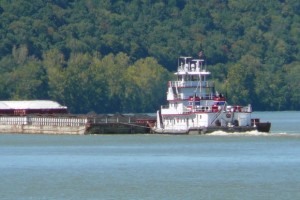When Anne Hendrickson, one of our partners, moved to Kansas City from Omaha after law school, she wasn’t familiar with the city. Anne was going to be working in downtown Kansas City for a Jackson County Circuit Court Judge and decided to live up north, as she didn’t know any of the neighborhoods closer to town. Anne is an adventurer at heart and spent many weekends exploring the metropolitan area, including Weston, Missouri, attractive to Anne for its historic downtown and mead production. Fourteen years later, Weston still holds a soft spot in Anne’s heart. If you haven’t visited Weston, there are a number of interesting facts to discover. For example, did you know that Weston, Missouri, at one time was the second largest port on the Missouri River, with St. Louis (not Kansas City) being the only one larger? In the mid 1850s, over 265 steamboats per year docked in Weston; the population of 5,000 folks was larger than that of St. Joseph and Kansas City. Flood, fire and war decimated the city and it now has fewer than 2,000 residents.  Today, people visit Weston to enjoy its slice of America’s heritage, including antebellum homes, museums, tobacco barns, orchards, the old McCormick distillery, Pirtle Winery and an operating brewery on the site of the oldest brewery west of Hudson River. Pursuant to an agreement between William Clark (who was then stationed in St. Louis), the U.S. Government bought the land upon which Weston sits from the Sac, Fox and Ioway tribes for about $7,500 in 1836. The ceremony took place at Ft. Leavenworth, which was one of Clark’s later stops on his way to discover the Great Northwest. The Lewis and Clark Expedition camped out near the location of today’s city hall. Weston was the oldest settlement in the Platte Purchase and was therefore also the farthest western settlement in the United States until the admission of Texas as a state in 1845, thus giving rise to one of the divergent stories about how the town got its name (West Town). Annexation of the Platte Purchase lands was approved by the Missouri Legislature on November 21, 1836, and with it the state briefly became the largest in the Union by geographic size. William “Buffalo Bill” Cody was at one time a resident of Weston, and the town was a major “jumping off” point for the Santa Fe Trail, the Oregon Trail and the California Gold Rush. Today, the town has a natural charm and a main street that boasts many colorful shops and restaurants. Located just a half hour north of downtown Kansas City, it is no wonder Weston is routinely recognized as one of the best day trips for residents of the Kansas City area.
Today, people visit Weston to enjoy its slice of America’s heritage, including antebellum homes, museums, tobacco barns, orchards, the old McCormick distillery, Pirtle Winery and an operating brewery on the site of the oldest brewery west of Hudson River. Pursuant to an agreement between William Clark (who was then stationed in St. Louis), the U.S. Government bought the land upon which Weston sits from the Sac, Fox and Ioway tribes for about $7,500 in 1836. The ceremony took place at Ft. Leavenworth, which was one of Clark’s later stops on his way to discover the Great Northwest. The Lewis and Clark Expedition camped out near the location of today’s city hall. Weston was the oldest settlement in the Platte Purchase and was therefore also the farthest western settlement in the United States until the admission of Texas as a state in 1845, thus giving rise to one of the divergent stories about how the town got its name (West Town). Annexation of the Platte Purchase lands was approved by the Missouri Legislature on November 21, 1836, and with it the state briefly became the largest in the Union by geographic size. William “Buffalo Bill” Cody was at one time a resident of Weston, and the town was a major “jumping off” point for the Santa Fe Trail, the Oregon Trail and the California Gold Rush. Today, the town has a natural charm and a main street that boasts many colorful shops and restaurants. Located just a half hour north of downtown Kansas City, it is no wonder Weston is routinely recognized as one of the best day trips for residents of the Kansas City area.
Footer
© Van Osdol, PC. All rights reserved.
The choice of a lawyer is an important decision and should not be based solely upon advertisements.
